【英语】非谓语动词(完整版)
- 格式:doc
- 大小:63.50 KB
- 文档页数:9
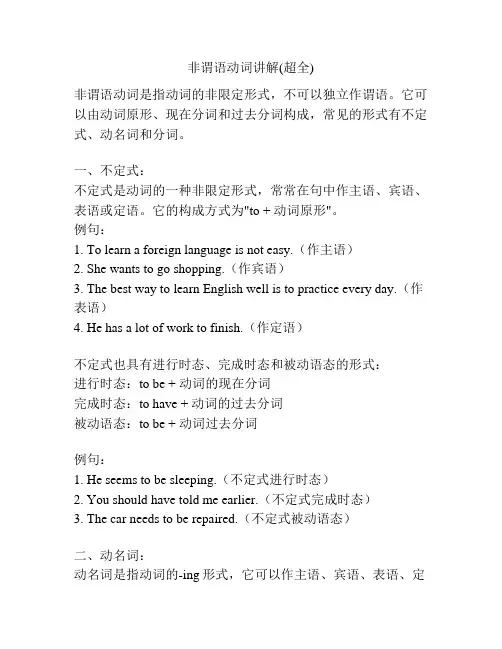
非谓语动词讲解(超全)非谓语动词是指动词的非限定形式,不可以独立作谓语。
它可以由动词原形、现在分词和过去分词构成,常见的形式有不定式、动名词和分词。
一、不定式:不定式是动词的一种非限定形式,常常在句中作主语、宾语、表语或定语。
它的构成方式为"to + 动词原形"。
例句:1. To learn a foreign language is not easy.(作主语)2. She wants to go shopping.(作宾语)3. The best way to learn English well is to practice every day.(作表语)4. He has a lot of work to finish.(作定语)不定式也具有进行时态、完成时态和被动语态的形式:进行时态:to be + 动词的现在分词完成时态:to have + 动词的过去分词被动语态:to be + 动词过去分词例句:1. He seems to be sleeping.(不定式进行时态)2. You should have told me earlier.(不定式完成时态)3. The car needs to be repaired.(不定式被动语态)二、动名词:动名词是指动词的-ing形式,它可以作主语、宾语、表语、定语或状语。
在句中的位置和用法与名词相似。
例句:1. Reading is my favorite hobby.(作主语)2. I enjoy swimming in the summer.(作宾语)3. Her dream is becoming a famous singer.(作表语)4. The girl standing over there is my sister.(作定语)5. He went to the party without saying goodbye.(作状语)动名词与不定式的区别在于动名词具有进行时态和被动语态,而不定式没有。
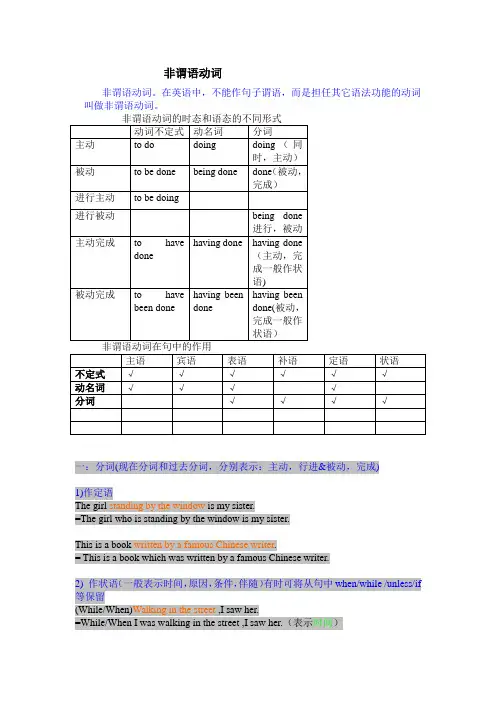
非谓语动词非谓语动词。
在英语中,不能作句子谓语,而是担任其它语法功能的动词叫做非谓语动词。
非谓语动词的时态和语态的不同形式动词不定式动名词分词主动to do doing doing(同时,主动)被动to be done being done done(被动,完成)进行主动to be doing进行被动being done进行,被动主动完成to havedone having done having done(主动,完成一般作状语)被动完成to havebeen done having beendonehaving beendone(被动,完成一般作状语)非谓语动词在句中的作用主语宾语表语补语定语状语不定式√√√√√√动名词√√√√分词√√√√一:分词(现在分词和过去分词,分别表示:主动,行进&被动,完成)1)作定语The girl standing by the window is my sister.=The girl who is standing by the window is my sister.This is a book written by a famous Chinese writer.= This is a book which was written by a famous Chinese writer.2) 作状语(一般表示时间,原因,条件,伴随)有时可将从句中when/while /unless/if 等保留(While/When)Walking in the street ,I saw her.=While/When I was walking in the street ,I saw her.(表示时间)Seen from the hill,our school looks more beautiful.=When our school is seen from the hill,it looks more beautiful.从小山上看,我们学校更美了。


非谓语动词一、非谓语动词的概念非谓语形式有三种: 1.动词不定式:to do表示目的和将来2、动词的ing(动名词) : doing表示主动和进行 3.动词的过去分词:done表示被动和完成二、非谓语动词的时态和语态一般式完成式进行式不定式主动to do to have done to be doing被动to be done to have been doneing 形式主动doing having done被动being done having been done过去分词被动done三、非谓语动词的做题步骤:1、判定是否用非谓语形式。
方法:看看句子中是否已有了谓语动词了。
2、找非谓语动词的逻辑主语。
方法:非谓语动词的逻辑主语一般是句子的主语。
3、判断主被动关系。
方法:非谓语动词与其逻辑主语的主动还是被动关系。
4、判断时间关系。
方法:分析句子,看看非谓语动词所表示的动作发生在谓语动作之前、之后还是同时。
之前常用done; 之后常用to do; 同时常用doing。
一、非谓语动词作主语和表语的比较1、不定式和动名词作主语和表语:1). 不定式表示一次性的、具体的动词。
动词ing 常表示一般的、泛指的或习惯性的动作。
如:________ is a good form of exercise for both young and old.A. The walkB. WalkingC. To walkD. Walk2). 不定式作主语时,常用it 作形式主语,即用句型:It is + adj. / n. + (for / of sb. ) to do sth.It’s important for us to learn English well. It’s kind of you to help us.注意:下面几个句型是用动名词:It’s no good / use doing sth. There is no point(in)doing sth2、不定式、动名词、分词作表语的比较:1)、不定式、动名词作表语,.表示主语的内容。
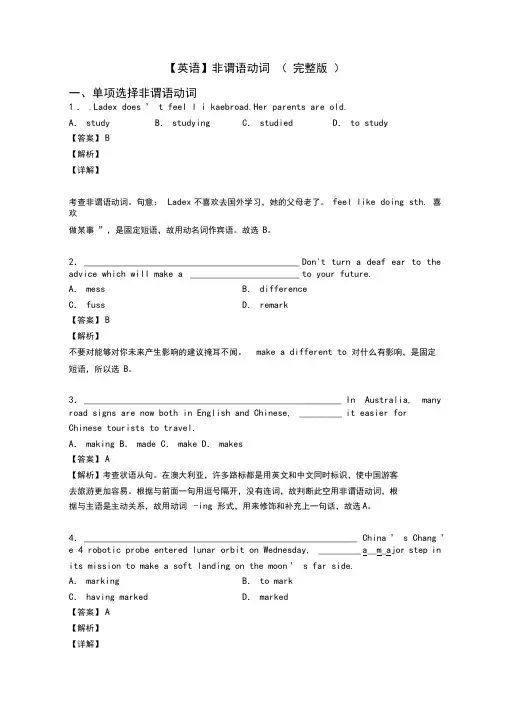
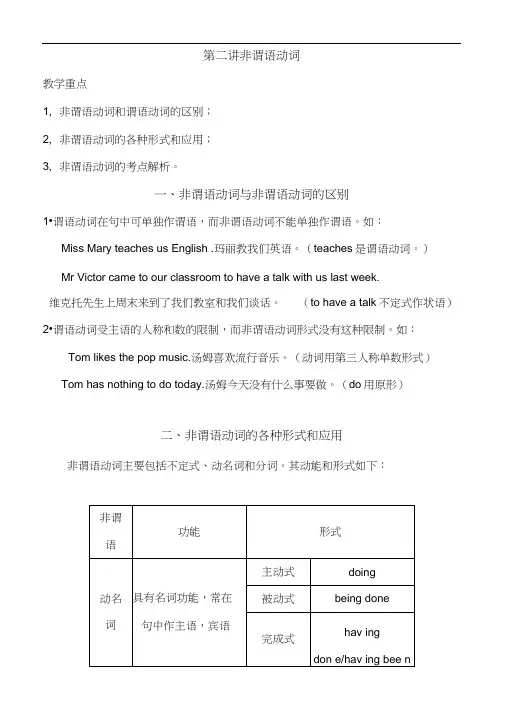
第二讲非谓语动词教学重点1, 非谓语动词和谓语动词的区别;2, 非谓语动词的各种形式和应用;3, 非谓语动词的考点解析。
一、非谓语动词与非谓语动词的区别1•谓语动词在句中可单独作谓语,而非谓语动词不能单独作谓语。
如:Miss Mary teaches us English .玛丽教我们英语。
(teaches是谓语动词。
)Mr Victor came to our classroom to have a talk with us last week.维克托先生上周末来到了我们教室和我们谈话。
(to have a talk不定式作状语)2•谓语动词受主语的人称和数的限制,而非谓语动词形式没有这种限制。
如:Tom likes the pop music.汤姆喜欢流行音乐。
(动词用第三人称单数形式)Tom has nothing to do today.汤姆今天没有什么事要做。
(do用原形)二、非谓语动词的各种形式和应用非谓语动词主要包括不定式、动名词和分词。
其动能和形式如下:非谓语动词在句中所做的成分如下:三、考点解析非谓语动词一直是高考中的热点。
解答非谓语动词的题目时,一定要解析句子结构,确定所设空是谓语动词还是非谓语动词,以及非谓语动词在句子中充当的功能(如状语、定语或宾补);找准相关动词的逻辑主语,确定该动词与逻辑主语是什么关系(主动还是被动);搜索句子中相关的时间信息,确定非谓语动词的恰当形式。
1 动名词和不定式作表语①如果表语是不定式,主语也是不定式;表语是动名词,主语也是动名词。
如:To see is to believe= See ing is believ ing.②动名词作主语的句型。
如:It is no use/no good/useless doing sth.It is a waste of time doing(也可用It is a waste of time to do)③动词不定式和动名词的复合结构:动词不定式的复合结构有两种:It is difficult/easy/possible/necessary/...for sb. to do sth和It is kind/wise/foolish/considerate/...of sb. to de。
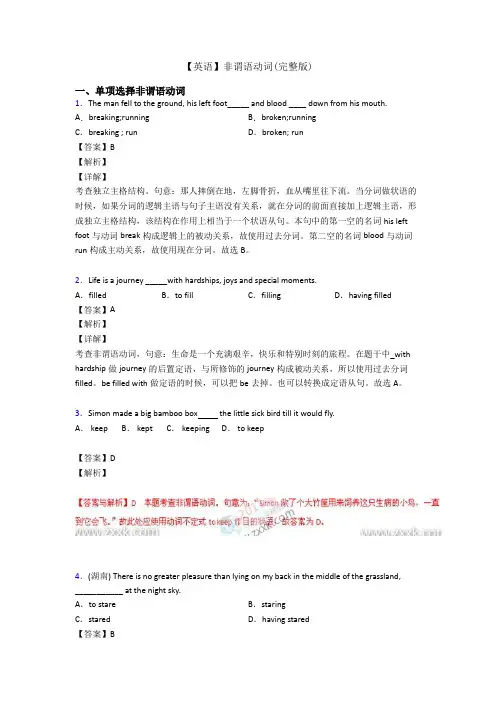
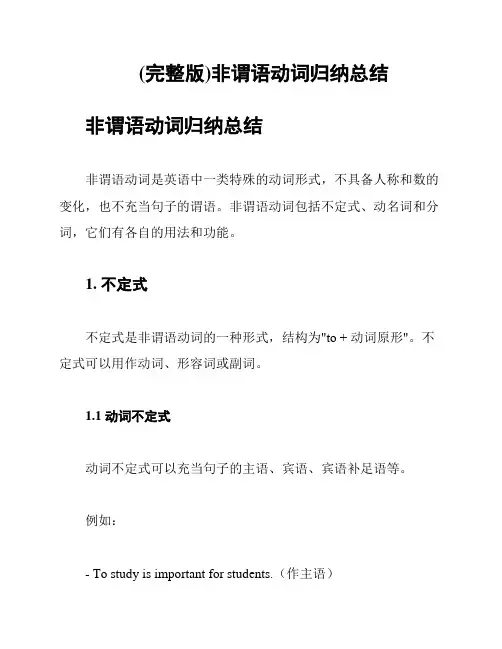
(完整版)非谓语动词归纳总结非谓语动词归纳总结非谓语动词是英语中一类特殊的动词形式,不具备人称和数的变化,也不充当句子的谓语。
非谓语动词包括不定式、动名词和分词,它们有各自的用法和功能。
1. 不定式不定式是非谓语动词的一种形式,结构为"to + 动词原形"。
不定式可以用作动词、形容词或副词。
1.1 动词不定式动词不定式可以充当句子的主语、宾语、宾语补足语等。
例如:- To study is important for students.(作主语)- I want to learn English.(作宾语)- She asked me to help her.(作宾语补足语)1.2 形容词不定式形容词不定式用于修饰名词或代词。
例如:- I have a book to read.(修饰名词)- He is the man to trust.(修饰代词)1.3 副词不定式副词不定式用于修饰动词、形容词或副词。
例如:- She worked hard to pass the exam.(修饰动词)- He is happy to see you.(修饰形容词)- She walked quickly to catch the bus.(修饰副词)2. 动名词动名词是非谓语动词的一种形式,结构为动词的现在分词形式。
动名词可以充当句子的主语、宾语、宾语补足语等。
例如:- Swimming is good exercise.(作主语)- I enjoy playing basketball.(作宾语)- She kept on talking.(作宾语补足语)3. 分词分词是非谓语动词的一种形式,根据时态和完成程度的不同,分词分为现在分词和过去分词。
3.1 现在分词现在分词用于表示主动或进行的动作。
例如:- The running boy is my brother.(作定语)- She stood there, crying.(作状语)3.2 过去分词过去分词用于表示被动或完成的动作。
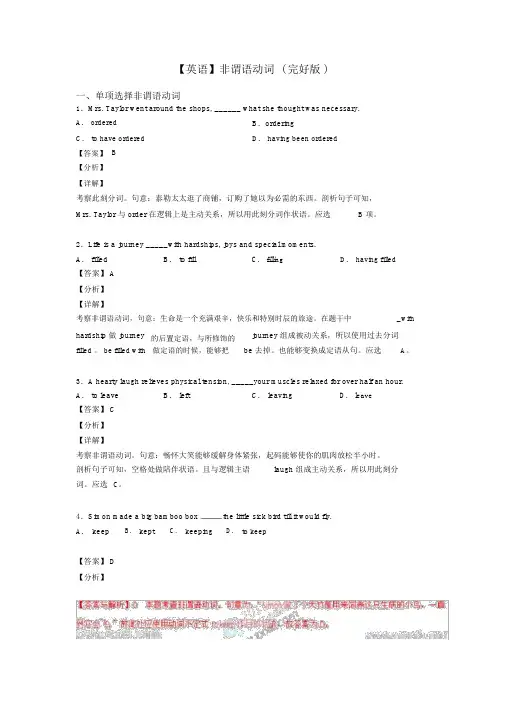
【英语】非谓语动词 ( 完好版 )一、单项选择非谓语动词1.Mrs. Taylor went around the shops, ______ what she thought was necessary.A. ordered B.orderingC. to have ordered D. having been ordered【答案】B【分析】【详解】考察此刻分词。
句意:泰勒太太逛了商铺,订购了她以为必需的东西。
剖析句子可知,Mrs. Taylor 与 order 在逻辑上是主动关系,所以用此刻分词作状语。
应选 B 项。
2.Life is a journey _____with hardships, joys and special moments.A. filled B. to fill C. filling D. having filled【答案】 A【分析】【详解】考察非谓语动词,句意:生命是一个充满艰辛,快乐和特别时辰的旅途。
在题干中_withhardship 做 journey filled 。
be filled with 的后置定语,与所修饰的做定语的时候,能够把journey 组成被动关系,所以使用过去分词be 去掉。
也能够变换成定语从句。
应选A。
3.A hearty laugh relieves physical tension, _____your muscles relaxed for over half an hour. A. to leave B. left C. leaving D. leave【答案】 C【分析】【详解】考察非谓语动词。
句意:畅怀大笑能够缓解身体紧张,起码能够使你的肌肉放松半小时。
剖析句子可知,空格处做陪伴状语。
且与逻辑主语laugh 组成主动关系,所以用此刻分词。
应选C。
4.Simon made a big bamboo box the little sick bird till it would fly.A.keep B.kept C.keeping D.to keep【答案】 D【分析】5.Pressed from his parents, and ____ that he has wasted too much time, the boy is determined to stop playing video games.A.realizing B.realizedC. to realize【答案】 AD. being realized【分析】试题剖析:考察非谓语动词的用法。

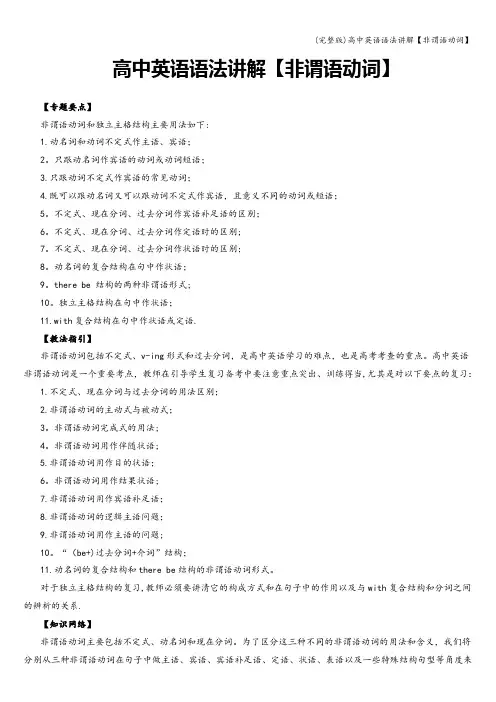
高中英语语法讲解【非谓语动词】【专题要点】非谓语动词和独立主格结构主要用法如下:1.动名词和动词不定式作主语、宾语;2。
只跟动名词作宾语的动词或动词短语;3.只跟动词不定式作宾语的常见动词;4.既可以跟动名词又可以跟动词不定式作宾语,且意义不同的动词或短语;5。
不定式、现在分词、过去分词作宾语补足语的区别;6。
不定式、现在分词、过去分词作定语时的区别;7。
不定式、现在分词、过去分词作状语时的区别;8。
动名词的复合结构在句中作状语;9。
there be 结构的两种非谓语形式;10。
独立主格结构在句中作状语;11.with复合结构在句中作状语或定语.【教法指引】非谓语动词包括不定式、v-ing形式和过去分词,是高中英语学习的难点,也是高考考查的重点。
高中英语非谓语动词是一个重要考点,教师在引导学生复习备考中要注意重点突出、训练得当,尤其是对以下要点的复习:1.不定式、现在分词与过去分词的用法区别;2.非谓语动词的主动式与被动式;3。
非谓语动词完成式的用法;4。
非谓语动词用作伴随状语;5.非谓语动词用作目的状语;6。
非谓语动词用作结果状语;7.非谓语动词用作宾语补足语;8.非谓语动词的逻辑主语问题;9.非谓语动词用作主语的问题;10。
“(be+)过去分词+介词”结构;11.动名词的复合结构和there be结构的非谓语动词形式。
对于独立主格结构的复习,教师必须要讲清它的构成方式和在句子中的作用以及与with复合结构和分词之间的辨析的关系.【知识网络】非谓语动词主要包括不定式、动名词和现在分词。
为了区分这三种不同的非谓语动词的用法和含义,我们将分别从三种非谓语动词在句子中做主语、宾语、宾语补足语、定语、状语、表语以及一些特殊结构句型等角度来区分其用法和细微含义。
1.不定式和动名词作主语的区别(1)动名词作主语通常表示抽象动作;而不定式作主语表示具体动作.Smoking is prohibited(禁止)here.这里禁止抽烟。
非谓语动词(完整版)非谓语动词(完整版)一、单项选择非谓语动词1.The woman began to cry when asked how her husband was injured.解析:本句中,how引导的是宾语从句,asked是谓语动词,所以用过去分词作状语,表示被动,故选A。
2.XXX tasted terrible。
so it was thrown away by the child.解析:本句中,taste与主语medicine是主动关系,而且taste是系动词无被动,因此用现在分词tasting作状语,表示主动,故选B。
3.A XXX。
XXX for over half an hour.解析:本句中,leaving与主语laugh构成主动关系,表示结果,所以用现在分词,故选C。
4.When asked for his views about his teaching job。
Philip said he found it very interesting and rewarding.解析:本句中,when引导的是省略句,完整的是when he was asked his view about his job as a teacher,这里当从句中的主语与主句的主语一致,并且从句的谓语动词有be时,这时从句的主语与be同时省略,故选B。
二、改写句子1.Being asked how her husband was injured。
XXX.2.XXX.3.A XXX for over half an hour.4.Philip found XXX when he was asked for his views about it.1.The company has decided to implement a new policy to ce the use of plastic bags。
【英语】非谓语动词(完整版)一、单项选择非谓语动词1.224. The murderer was brought in, with his hands _____ behind his back.A.being mopped B.having tied C.to be tied D.tied【答案】D【解析】【详解】考查非谓语动词。
句意:那个谋杀犯被带了进来,手被捆在背后。
with的宾语his hands与动词tie构成被动的关系,故使用过去分词。
故选D。
2. Hours of playing violent video games can affect the way the brain works, ______ damage to certain cells of brain.A.to cause B.cause C.causing D.caused【答案】C【解析】试题分析:考查非谓语动词。
causing 现在分词作结果状语。
句意:连续几个小时打暴力的电子游戏会影响大脑的工作方式,危害大脑细胞并减慢大脑的活动。
故C正确。
考点:考查非谓语动词3.115.______ his love, Chris sent his mom a thank-you note on Mother’s Day. A.Expressing B.Expressed C.To express D.Having expressed【答案】C【解析】考查动词不定式。
句意:为了表达他的爱,克里斯在母亲节那天给他的妈妈寄了一条感谢信。
用不定式表目的,故选C。
4.______ to nuclear radiation, even for a short time, may influence genes in human bodies. A.Having exposed B.Being exposedC.To expose D.Exposed【答案】B【解析】【详解】考查动名词。
非谓语动词归纳总结一,非谓语动词的形式变化及其意义二,非谓语动词的运用及考题形式形式1,(If/Unless/When/Though/As)( )----------------------,句子(主语+谓语+宾语-----)(1)To do-----表目的(为了),发生谓语动词后,后面常带宾语(2)Doing/Having done----(当---时,如果,虽然,因为),后面常带宾语(3)Done/Having been done----(当---时,如果,虽然,因为),后面不带宾〖注意〗:1,(Do )---------------, and/but/or/if/when/before/after+主语+谓语+--------这是祈使句,所以用动词原2,(Doing/Being done)------------------is/was(谓语动词)-----------------------------------.这是用动名词作主语〖例证〗:1,______(look)carefully,and you can find the differences between the two pictures.2,______(look)after his aged mother, he gave up the chance to go abroad for further study.3,_______(look) after yourself well is important when you are alone abroad.4,_______(look) after well by the nurse, the old man recovered quite quickly.5,_______(look) after well is a kind of love that our parents gave us.6,_______(look) for the book for a long time, he finally bought it in a bookstore occasionally.7,_______(look) after well by the nurse for two months,the old man finally recovered.形式2主语+谓语+宾语+------,()+------------1,doing(及物动词后面跟宾语)表示伴随,结果,方式2,done(及物动词后面不跟宾语)表示伴随,结果,方式3,only to do表示结果〖例证〗1,A hearty laughter releases physical tension, ( )(leave) our muscle relaxed for half an hour. 2,The old grandma got off the bus, ()(support)by her granddaughter.3,We hurried to the railway station, only( )(find) the train had already left.4,He got up,washed his faces,had his breakfast, and( )(go) to work.形式3主语()+ 谓语+ 宾语()+-------------1,to do将要做的to be done将被做的(作定语或宾语补足语)2,doing正在做的being done正在被---的(作定语或宾语补足语)3,done被----了的(作定语或宾语补足语)〖例证〗1,Anyone________(see)________(carry)bags,boxes,cases was stopped by the police.(作定语)2,Steam can be seen__________(rise) when water is heated.(作主语补足语)3,Seeing the roads _____(cover) with snow and ice, we decided to stay at home.(作宾语补足语)4,The building _________(complete) next month will be used as a laboratory.(作定语)5,The problem______(discuss) now is not the one _____(discuss)at yesterday’s meeting (作定语)6,He spoke loudly enough to make himself __________(hear) clearly.(作宾语补足语)7,The government has taken effective measures________(improve) the air condition in Beijing.(作目的状语)8,Don’t keep the water ________(run) when you brush teeth.(作宾语补足语)三,固定搭配1,跟不定式作宾语的动词Aim,appear,agree,arrange,decide,choose,demand,desire,determine,expect,hope,fail,happen, hesitate,learn,mean,manage,offer,plan,prepare,pretend,promise,refuse,attempt,want2,跟动名词作宾语的动词Consider,suggest,advise,excuse,pardon,admit,delay,putoff,fancy,avoid,miss,keep,practice,deny,finish,enjoy,appreciate,can’t help,forbid,imagine,risk,mind,allow,permit,escape3,to后面跟动名词的短语Be/get used to,be related to,be addicted to,be opposed to,be devoted to,be adjusted to,be connected to,be compared to,lead to,object to,look forward to,stick to,pay attention to,contribute to,make contributions to,reply to,turn to,belong to,respond to。